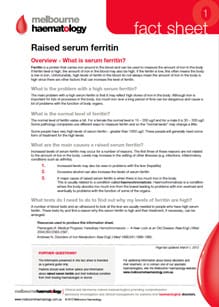Overview
Iron deficiency is the most common cause of anaemia (decrease in the number of red blood cells), affecting over one billion people in the world. Iron is essential for the formation of haemoglobin, the main component of red blood cells. Haemoglobin is essential to carry oxygen from the lungs to all tissues in the body.
Where does iron in our bodies come from?
Iron comes from the diet. Sources of food containing high levels of iron include red meat and liver. Smaller amounts are found in white meats/fish, fortified breakfast cereals, beans, seeds/pulses, green vegetables, tofu and eggs.
Diagnosis
How is iron deficiency diagnosed?
When the level of red blood cells is also reduced, this is diagnostic of iron deficiency anaemia.
Sometimes other blood tests are required to diagnose iron deficiency in circumstances when the ferritin level may be falsely raised.
Symptoms & Causes of Iron Deficiency Anaemia (IDA)
What are the symptoms of iron deficiency anaemia?
Iron deficiency commonly causes tiredness, fatigue and pale skin.
If severe, it can also cause breathlessness on exertion, hair changes/hair loss, nail changes, tinnitus (ringing in the ears) and occasionally strange cravings for non-food substances (pica). This is most commonly a craving for ice, but can also include dirt, coal and other substances.
What are the causes of iron deficiency?
The main causes of iron deficiency are:
What tests are done to identify the cause for iron deficiency?
The doctor will ask questions to identify the most likely reason for iron deficiency from the above list. Tests would be guided by the most likely reason and may include blood tests (to identify absorption problems), investigations to identify blood loss from the intestine (stool test for blood), telescope tests on the upper and lower intestine (gastroscopy and/or colonscopy) or ultrasound of the pelvis in women with increased menstrual bleeding.
Treatment & Management
How is iron deficiency treated?
Iron deficiency is treated by taking iron replacement treatment.
Iron Replacement Therapies:
There are several safe iron preparations for intravenous administration; the treatment may be given in a hospital or at a doctor’s surgery, depending on the available facilities.
Injections of iron into the muscle (usually into the arm or buttock) are not recommended, as they may cause permanent discolouration of the skin, and are usually painful).
When is a blood transfusion needed?
A blood transfusion is different to iron replacement therapy. A blood transfusion is “pre-made” red blood cells from another person. As such it works much quicker than iron replacement therapy (where your own body makes the new red blood cells after the iron is given), but there are potential side effects from transfusions, and blood is a precious resource.
Blood transfusions in iron deficiency are used only for severe anaemia, with associated symptoms related to the heart or lungs (chest pains, palpitations, and breathlessness).
Will the iron deficiency recur?
It is essential to identify the underlying cause for the iron deficiency anaemia. If this is identified and treated (eg. Diet changes, treatment for blood loss from the intestine), the iron deficiency will not recur.
Regular blood tests are recommended after treatment of iron deficiency, to monitor iron levels and identify drop in iron levels, prior to the development of anaemia.

in 5000 people has HS
people in Melbourne
population of Melbourne*
What does having HS mean?
There are three main common problems associated with having HS:
There is another uncommon potential problem for people who have Hereditary Spherocytosis associated with a viral infection called “Slapped cheek”. Slapped cheek is caused by a virus called Parvovirus which can infect bone marrow cells and put the red cell producing cells “to sleep”. Because patients with HS need the bone marrow to be rapidly replacing the fragile red cells, this infection can cause a severe anaemia; patients can become very pale and sometimes even require blood transfusions. Fortunately this problem is uncommon.
Diagnosis
How is Hereditary Spherocytosis diagnosed?
HS is now diagnosed with a simple blood test. It is also important for a doctor to examine patients with HS to see if they are jaundiced or have an increase in the size of the spleen.
Treatment & Management
What do I need to do now that I (or my child) has been diagnosed with Hereditary Spherocytosis?
Most patients with HS do not need to do much about their condition at all. The bone marrow has the capacity to increase the number of red cells it produces many fold and is able to keep up replacing the fragile cells.
A few things may be helpful:
Will I (or my child) need a splenectomy?
Removing the spleen (splenectomy) has been used a lot in the past in the treatment and management of patients with HS; it stops the red cells from breaking down and solves the problems of HS.
Removing the spleen has problems however – the spleen is an important organ in the immune system and patients who do not have a spleen may be prone to getting serious infections. This risk is higher in younger children but may be less than previously expected because of newer vaccinations. It is now generally recommended to avoid splenectomy in children younger than 6 years and to ensure that children who may need a splenectomy have all the appropriate vaccinations.
Another approach for some of these young patients is to remove only a small part of the spleen – partial splenectomy. This is done in a few hospitals and there is some experience to say this may be very helpful for some patients.
Resources used to produce this information sheet.
- Diagnosis and management of iron deficiency anaemia: a clinical update:
https://www.mja.com.au/journal/2010/193/9/diagnosis-and-management-iron-deficiency-anaemia-clinical-update - Iron-are you getting enough?
http://www.ausport.gov.au/ais/nutrition/factsheets/basics/iron_-_are_you_getting_enough - Oral preparations for iron deficiency anaemia treatment
http://www.transfusion.com.au/transfusion_practice/anaemia_management/iron_deficiency_anaemia/oral_preparations
Further Questions?
The information presented in this fact sheet is intended as a general guide only.
Patients should seek further advice and information about Iron Deficiency Anaemia and their individual condition from their treating haematologist or doctor.



